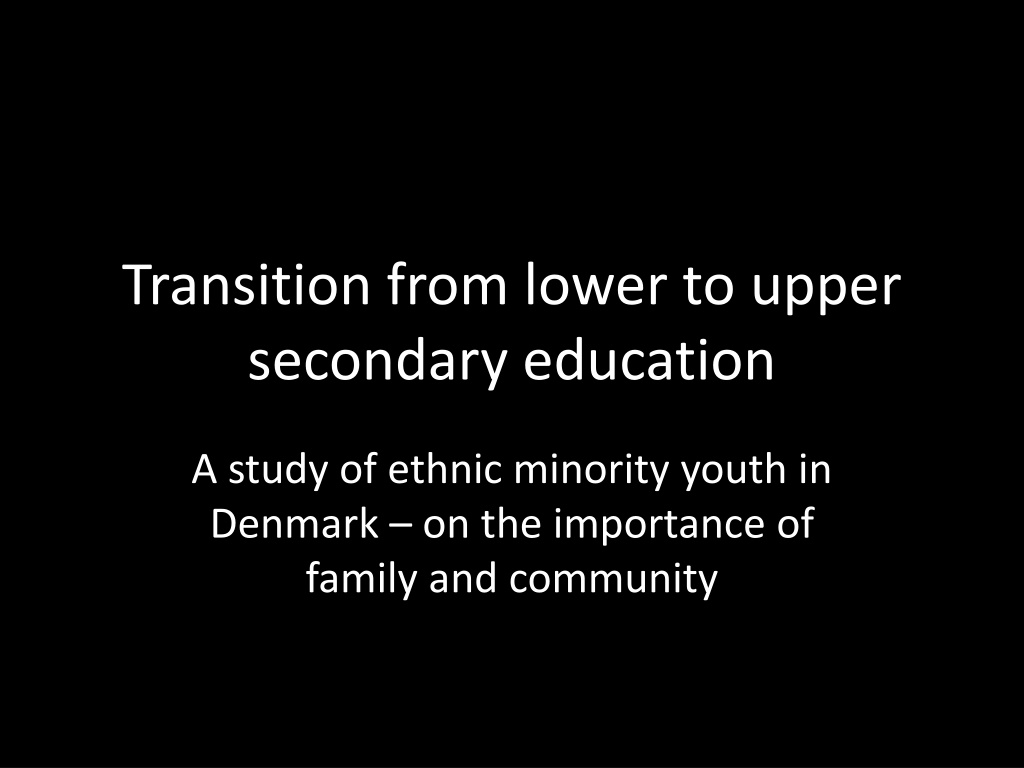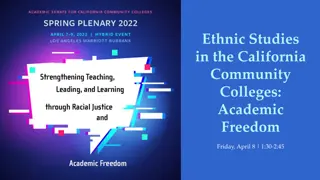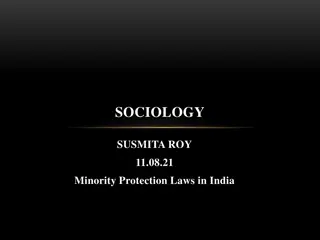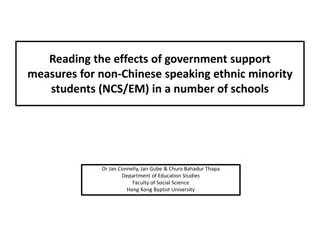Understanding the Impact of Family and Community on Ethnic Minority Youth's Transition to Upper Secondary Education in Denmark
Study explores the influence of family and community support on the academic achievement and school affiliation of ethnic minority youth in Denmark. It examines social capital, dropout rates, and the role of family and ethnic community bonding in a monocultural school system. Key findings highlight the significance of social networks in educational outcomes.
Download Presentation

Please find below an Image/Link to download the presentation.
The content on the website is provided AS IS for your information and personal use only. It may not be sold, licensed, or shared on other websites without obtaining consent from the author. Download presentation by click this link. If you encounter any issues during the download, it is possible that the publisher has removed the file from their server.
E N D
Presentation Transcript
Transition from lower to upper secondary education A study of ethnic minority youth in Denmark on the importance of family and community
Social communities and school affiliation An ethnographic field study on the implications of social community on school achievement and school affiliation A socially challenged neighborhood in Copenhagen Six weeks of observations in a graduating school class, the neighborhood in which the school is located, and interviews with the youth and the professionals working with them
Ethnic minority youth, family and education A smaller part of the project dealing with the relation between social capital (family capital and ethnic capital) and its impact on school achievement and school affiliation Hypothesis: social capital, understood as resources in the extended family and in the ethnic community, become invisible in a monocultural school system and are valued lesser in a monocultural society
Some background figures 15-20 % of all students drop out of upper secondary before graduation 35 % of all dropouts have ethnic minority background Differences in figures depending on type of secondary education 70 % of dropouts can in part be explained by parents educational background
Social capital Social capital are those resources that are embedded in the social network Bonding social capital a strong form of social capital that enforces existing networks, but are limited in their transferability Bridging social capital the resources used and recognized in the processes of making different networks accesible to one another has transferability and connects different types of network
Family Capital and Ethnic Capital Social capital in the family in the ethnic community and how it meets the demands and structures of the surrounding community Can be recognized as weak or strong depending on its bonding qualities More often that not, family capital in the ethnic minority community is characterized by strong bonding capital and weak bridging capital
Why social capital in our study? Social capital in the families of the informants and in the ethnic community is a bonding social capital, thus becomes weak social capital in an school setting The narratives of weak social capital in the ethnic minority families emphasize and enforce a social inequality in the school system
Family Capital and social mobility Poor educational capital does not necessarily equal poor family capital Family capital can not be directly translated into acknowledged social capital, thus making social mobility difficult in spite of a high degree of family capital When parents fail to help (language issues, long working hours, lack of knowledge of educational system), siblings and cousins contribute to social mobility through their experience
The extended family an inspiration to education In all interviews, informants refer to a member of the family as educated The narrative of the family as well educated is used as arguments for choice of further education or for educating oneself at all The link between the narratives of the youth and the common understanding of the families ability to support an educational strategy is however lacking
Ethnic capital and social capital Andr is 15 years old and of Montenegrin descent. He lives with his parents and siblings in the vicinity of the school. What characterizes Andr is his affiliation with basketball. He plays on a semi-professional level and dedicates all his time to practice. Andr s parents support his training by giving him an allowance so that he doesn t have to work after school, and they also support him by encouraging his development in the basketball club. The other players are also of Montenegrin descent and the parents all know each other; as Andr says: Everybody from Montenegro, who lives in Denmark, know each other. I don t know why, maybe because we have something in common, maybe because we have a shared history . In the basketball club Andr develops different skills such as teamwork, perseverance and overseeing complex situations, however, in school Andr is considered inattentive and is easily distracted by his friends.
Ethnic capital a battle between narratives Mariya is 15 years old and of Moroccan descent. She lives with her parents and her siblings. Mariya as well as her siblings originally went to a private school, which is a school characterized by a low number of ethnic minority pupils and high academic expectations. However, when money became an issue, they had to move the children. Mariya was at first anxious about starting at the public school as she thought the heavy concentration of ethnic minority pupils would make it a poorer school to attend, but now she is very happy to be there, as many of her friends from the neighborhood attend the school, and she performs better academically. Mariya has chosen her upper secondary school in part because: I didn t feel like going to X because I have been told that there are a lot of Danes attending, and I didn t feel like going to Y because I was told that there were too many immigrants, so at Z I was told that maybe there are 10 immigrants in each class
Ethnic capital and social mobility Sahar is 15 years old and lives with her parents and her younger brother close to the school. She has two older sisters who both live with girlfriends in apartments. They are both attending college. Sahar herself wishes to become a teacher when she grows up. Sahar is viewed by the teachers in school as a bright and dedicated, and she is planning on starting upper secondary in the fall. Where Sahar and her sisters are well on their way, her parents are concerned about her younger brother. They feel that the boys and young men in the neighborhood are a bad influence on him, and they feel that the neighborhood is holding him back. Sahar s understanding of the community is however ambivalent; on the one hand she agrees with the danger that the neighborhood constitute, but on the other she doesn t feel insecure; she wants to live in the vicinity when she grows up and she wants to be a teacher at her own school
The educational system a monocultural system Expresses concerns towards the deficiency of ethnic minority pupils (and their families) Based on a predominantly national curriculum Cooperation with families largely based on communicating the schools project and not vice-versa Operates through an assimilatory approach























